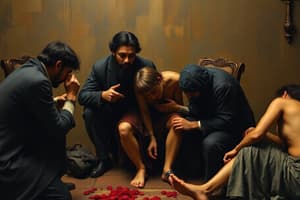Podcast
Questions and Answers
The Code of Hammurabi is the earliest recorded system of punishment, dating back to ancient Greece.
The Code of Hammurabi is the earliest recorded system of punishment, dating back to ancient Greece.
False (B)
The primary form of punishment in ancient times was imprisonment.
The primary form of punishment in ancient times was imprisonment.
False (B)
The Romans systematized their rules of punishment without any distinction between individuals.
The Romans systematized their rules of punishment without any distinction between individuals.
False (B)
Trial by ordeal was adopted by the Romans in ancient times as part of their judicial system.
Trial by ordeal was adopted by the Romans in ancient times as part of their judicial system.
The Spanish Inquisition targeted Jews who had converted to Protestantism.
The Spanish Inquisition targeted Jews who had converted to Protestantism.
Imprisonment as a form of punishment was present in ancient Egyptian society.
Imprisonment as a form of punishment was present in ancient Egyptian society.
Gladiator games in Rome resulted in very few deaths due to strict regulations.
Gladiator games in Rome resulted in very few deaths due to strict regulations.
The Brazen bull was a torture device used during Greek times.
The Brazen bull was a torture device used during Greek times.
The Spanish Inquisition required substantial evidence before accusing someone of heresy.
The Spanish Inquisition required substantial evidence before accusing someone of heresy.
Trial by ordeal was implemented when there was a lack of a proper judicial system.
Trial by ordeal was implemented when there was a lack of a proper judicial system.
Death was the main form of punishment in ancient times, including methods like beheading and crucifixion.
Death was the main form of punishment in ancient times, including methods like beheading and crucifixion.
The Egyptians had State-sanctioned methods of execution like beheading and burning.
The Egyptians had State-sanctioned methods of execution like beheading and burning.
During the Middle Ages in Europe, witchcraft was not considered a crime punishable by death.
During the Middle Ages in Europe, witchcraft was not considered a crime punishable by death.
The Inquisition, led by the clergy, focused on identifying and punishing traitors, while secular rulers dealt with witchcraft.
The Inquisition, led by the clergy, focused on identifying and punishing traitors, while secular rulers dealt with witchcraft.
Accusations in witch hunts were typically based on solid evidence rather than scapegoating innocent people.
Accusations in witch hunts were typically based on solid evidence rather than scapegoating innocent people.
The main goal of a witch trial was to rehabilitate the accused witches back into society.
The main goal of a witch trial was to rehabilitate the accused witches back into society.
England did not offer alternatives to execution for those accused of witchcraft.
England did not offer alternatives to execution for those accused of witchcraft.
The Iron Maiden and the French rack were some of the most infamous torture methods used during witch trials.
The Iron Maiden and the French rack were some of the most infamous torture methods used during witch trials.
Public executions in medieval Europe were rare occurrences.
Public executions in medieval Europe were rare occurrences.
The main purpose of public executions was to provide entertainment rather than deter crime.
The main purpose of public executions was to provide entertainment rather than deter crime.
The Tyburn Fair in London was known for its celebrations and festivals, not for executions.
The Tyburn Fair in London was known for its celebrations and festivals, not for executions.
Aristocrats in England were more likely to be punished by hanging than by beheading for capital crimes.
Aristocrats in England were more likely to be punished by hanging than by beheading for capital crimes.
The guillotine was invented during the French Revolution to make executions more painful and less efficient.
The guillotine was invented during the French Revolution to make executions more painful and less efficient.
In the 18th and 19th centuries, there was a movement towards more brutal forms of punishment instead of humane approaches.
In the 18th and 19th centuries, there was a movement towards more brutal forms of punishment instead of humane approaches.
Flashcards are hidden until you start studying
Study Notes
- Throughout history, torture and punishment have been used to maintain order and display power, with pain being a common thread.
- Michael Fay, an American teenager, was punished with a fine, prison time, and caning in Singapore for damaging cars with eggs and paint.
- The earliest recorded system of punishment dates back to ancient Babylon (18th century BC) with the Code of Hammurabi, which prescribed specific punishments for each crime.
- Death was the primary form of punishment in ancient times, with various methods such as beheading, burning, and crucifixion.
- The ancient Egyptians had State-sanctioned methods of execution, including beheading and burning.
- Imprisonment as a form of punishment did not exist in ancient times.
- Greek times saw the use of torture and capital punishment, with the Brazen bull being a notable innovation.
- The Romans systematized their rules of punishment, with a distinction between those who mattered and those who did not.
- Gladiator games emerged in Rome as a major public spectacle, involving thousands of deaths.
- Trial by ordeal was adopted in the Early Middle Ages when there was no real judicial system.
- The Spanish Inquisition, which began in 1478, targeted conversos (Jews who had converted to Catholicism) and required little evidence to accuse someone.
- Torture was used by the Inquisition to extract confessions, with various methods including the rack, the boot, and the strappado.
- Once a confession was obtained, religious punishments were given, but if someone refused to confess, their torture would continue until they were handed over to the secular authorities.
- Burning at the stake was a public form of punishment used to deter future transgressions and display the power of the church and state.- During the Middle Ages in Europe, witchcraft was a crime punished with death.
- The Inquisition, led by the clergy, focused on identifying and punishing heretics, while secular rulers and judges dealt with witchcraft.
- Rumors of immoral activities and a belief in a vast conspiracy of devil worshippers led to widespread witch hunts.
- Accusations were often based on scapegoating innocent people for societal misfortunes.
- Witch hunters used various tests to identify witches, such as the search for the devil's mark and the swimming test.
- The Malus Maleficarum, a manual for detecting witches, provided detailed instructions on persecution and torture.
- The goal of a witch trial was to extract a confession of guilt through various forms of torture, such as pressing and the rack.
- Witches were punished with death, typically by burning at the stake, though sometimes by strangulation or beheading.
- England offered alternatives to execution, such as imprisonment or banishment.
- Torture technology was refined during this period to extract information from suspected traitors and conspirators.
- The use of red-hot pincers, the Iron Maiden, and the French rack were some of the most infamous torture methods.
- Public executions were common and served as both a deterrent and religious instruction.- In medieval Europe, public executions were a common spectacle.
- Executions involved various methods, including hanging, drawing and quartering, and beheading, depending on the crime and social status of the offender.
- The main purpose of public executions was to serve as a deterrent to crime.
- Executions were often accompanied by parades of the condemned through the streets and displays of their bodies after the execution.
- The Tyburn Fair, where executions took place in London, was a popular place for crime and spectacle.
- The Condemned were sometimes given a moment of fame before their execution, allowing them to address the crowd and even sell souvenirs.
- The execution process was often slow and painful, with the use of ropes and carts.
- The English legal system liberally applied death by hanging as punishment for capital crimes, but aristocrats were shown more mercy and were usually beheaded.
- The invention of the guillotine during the French Revolution marked a shift towards swifter, less painful executions and greater fairness in sentencing.
- The use of public executions declined in the 18th and 19th centuries, as there was a growing movement towards more humane and less brutal forms of punishment.
- Prisons began to replace public executions as the primary means of punishment in the 19th century, with the United States leading the way in the development of penitentiaries as reformatories.
- The classic prison system, with its emphasis on iron discipline and isolation, was eventually recognized as failing to effectively deter crime or reform criminals.
- In the late 19th century, there was a trend towards normalization of life inside prisons, with the emphasis on rehabilitation and preparation for release into society.
- The court system and correction system also had to adapt to the new approach to imprisonment, with the introduction of parole boards, indeterminate sentencing, and the idea of releasing prisoners based on their performance in prison.
- The execution itself moved into the prison as a functional matter, but also due to the fear that public executions might repel people and lead to the abolition of capital punishment.
- There was a growing sense that the criminal justice system should become more humane and differentiate between those who could be saved and those who could not.
- The search for a humane method of execution continued, with various devices and methods being tried and refined throughout history.
Studying That Suits You
Use AI to generate personalized quizzes and flashcards to suit your learning preferences.




